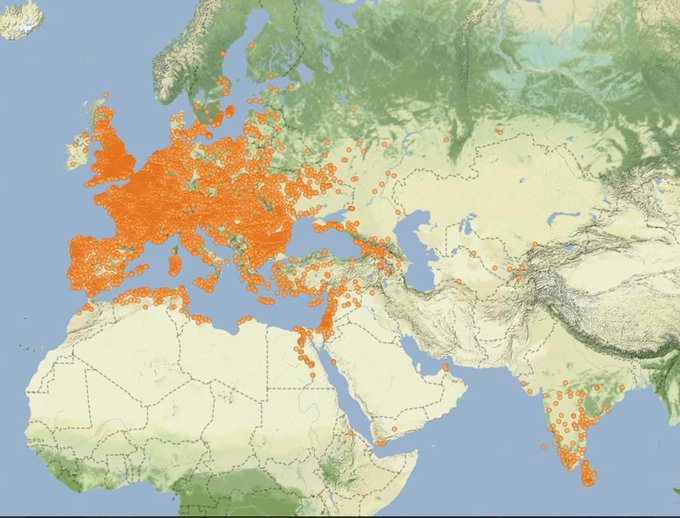Wow, they did not fuck with Ireland
History
Welcome to History!
A community dedicated to sharing and discussing fascinating historical facts from all periods and regions.
Rules:
-
Post about history. Ask a question about the past, share a link to an article about something historical, or talk about something related to history that interests you. Discussion is encouraged.
-
No memes. No ads. No promos. No politics. No spam.
-
No porn.
-
We like facts and reliable sources here. While sources like Quora/Reddit/Wikipedia can be great tools for quick searches, we do not allow such user-generated content as primary source. What’s wrong with Wikipedia?
NOTE: Personal attacks and insults will not be tolerated. Stick to talking about the historical topic at hand in your comments. Insults and personal attacks will get you an immediate ban.
Nothing worth pinching
The potatoes are amazing. Cause real trouble when they run out. /s
Edit: /s added for clarity.
That's a recent development, more recent than any sort of Roman occupation (Potatoes are South American)
Yeah, I know. In hindsight I should have put an “/s” on that comment.
I’d have guessed more would have been found in southern Italy.
Can't find them in a place that you don't look.
Rather, that part of Italy might not be interested in looking (or might not be publicizing when they do).
Sure they would.
OK.
The reason for that is that people in the heart of the empire didn't feel the need to hoard coins and bury them since they weren't nearly as exposed to barbarian threats (and others) like the areas on the fringes of the empire.
Dude the vast, vast majority of found coins found weren't buried intentionally.
By some estimates there were BILLIONS of Roman coins minted. They're absolutely all over the place.
Absolutely true for single finds, but I was talking more about hoards, which are usually more historically interesting. You can see, for example, how people hoarded high quality silver coins from the early imperial or even the republic period instead of spending them, opting to spend the contemporary debased currency instead.
I wonder what data this tracks
Doesn't show the Han/Byzantine trade: https://en.wikipedia.org/wiki/Sino-Roman_relations
Roman coins have been found as far east as Vietnam and Japan.
It looks like coins have been found on the sea routes that avoided the Parthian/Sassanian empires, but not on the overland routes. I’m guessing merchants exchanged their coins on the Roman/Persian frontier, east of which the Iranian coinage was the standard anyway; but in politically fractured places like southern India (south of the Kushans and Guptas), Roman coinage became the de facto currency of international trade.
So in other words, the distribution of coins outside the empire could reflect a regional demand for a standard international coinage, rather than Roman trade per se.
Anybody got some juicy (scientific) context for SW India and Sri Lanka? Commerce I suppose but in details, what, how and when? And how are you BTW?
A fascinating primary source is the Periplus of the Erythraean Sea(link to a complete translation in the article).
There's a book covering it:
https://en.wikipedia.org/wiki/The_Golden_Road:_How_Ancient_India_Transformed_the_World
Also, fine thank you.
I guess pepper is largely in the "what" mix
Spices.
Wish I could see a map like this with the finds colored by mint date.
I live kind of in the middle of several finds in an area without any. I wonder if that means there aren't any, or no one has bothered to seriously search for them.
Grab your shovel
Already have a detector and permit. But I still need permission from the farmers/landowners and that's trickier.
Maybe it's up to you to start digging
i like how they skipped over saudi arabia but got to yemen some how
I wonder if it's down to sea fairing and trade primarily.
Yeah, that seems to be the most likely explanation for how the coins got to India too. Egypt was the entry point into the Roman Empire, and there were maritime trade routes from the Red Sea to India.
Possible that there aren't as many archeologic diggings there
Amazing, thanks a lot.
Very cool map I haven't seen before, thank you!
It's so strange to me that the Romans went through central Europe, were they just taking the land route to the sea nations up north?
Yes—the Amber Road, the main trade route to the Baltic, did go through Central Europe.
And the reason trade went overland instead of by sea is because the Romans weren’t trading directly with the Baltic—they were paying soldiers stationed along the Danube and Rhine who then traded with neighboring peoples (and also directly subsidizing some frontier tribes), and the frontier peoples of Central Europe were then trading Roman gold for Baltic amber.
Well after Rome fell the currency was worthless, what else would you do with them? I mean it took 1500 years for them to be worth more than the metal they were minted on.
Not worthless. The coinage had intrinsic value, being made of metals with a commodity value. So it's not like holding a paper banknote when a government collapses. People would still have used them to hoard savings, for trade and melted down as a source of precious metals.
That was really the only value they ever had. Boosted a bit by confidence in the purity (but also reduced when Rome debased its coinage).
Southern Italy has always been poor. Water, infrastructure and so on
The source of the map is not provided in the OOP.
I think it’s very likely this map is biased in reporting.
I’ve heard roman coins are really common in some southern regions of italy. Perhaps to the point where finding them isn’t reported, and doesn’t end up on this map.

